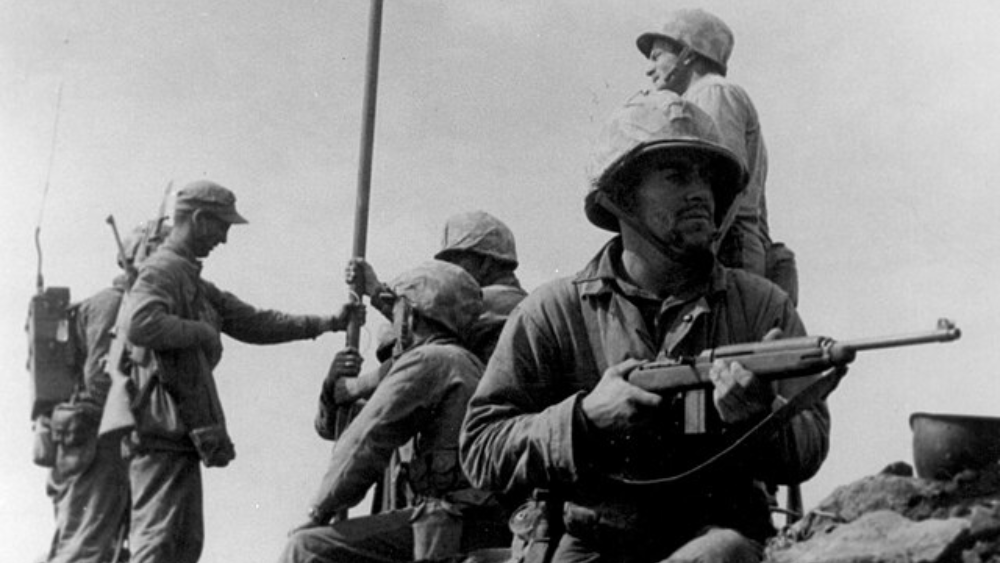History often remembers images more vividly than words. A single photograph can capture the essence of an entire moment, a nation’s struggle, and the sacrifices of its people. Such is the case with the iconic flag-raising on Iwo Jima. While Joe Rosenthal’s influential image of the second flag-raising has become one of the most recognized photographs in history, the first U.S. flag-raising was captured by another U.S. Marine combat photographer, Louis R. Lowery.
A U.S. Marine with a Camera
Born on July 24, 1916, in Pittsburgh, Pennsylvania, Louis Raymond Lowery had a passion for photography that led him to join the U.S. Marine Corps as a combat photographer. At a time when war correspondents and photographers were vital in documenting history, Lowery stood out for his bravery and skill. He wasn’t just an observer—he was a U.S. Marine first, carrying a camera instead of a rifle but often facing the same dangers as those who wielded weapons.
By 1945, the war in the Pacific was reaching its climax. The Battle of Iwo Jima, one of the bloodiest conflicts in U.S. Marine Corps history, was underway. The small volcanic island was of immense strategic importance, and the battle to seize it was fierce. Lowery, assigned to document the battle, found himself at the heart of one of the most significant moments of the war.
The First U.S. Flag Raising on Mount Suribachi
On February 23, 1945, after days of brutal combat, U.S. Marines finally reached the summit of Mount Suribachi, the highest point on Iwo Jima. As a symbol of victory and morale, a small group of U.S. Marines raised the first U.S. flag atop the mountain. Lowery was there, camera in hand, capturing the moment in real time. His photograph shows U.S. Marines standing proudly as the flag is hoisted, an image of triumph amidst the chaos of war.
Moreover, for those on the island and aboard ships watching from below, seeing the Stars and Stripes flying over Suribachi was a powerful and emotional sight. It marked the first time a U.S. flag had flown on Japanese soil in World War II—a symbol of hope and the beginning of the battle’s turning point.
The Second U.S. Flag Raising and the Overshadowing of Lowery’s Photo
Shortly after Lowery captured his historic photograph, officials ordered a larger U.S. flag to replace the first one, making it more visible from the beach. This second flag-raising event was the one captured by Joe Rosenthal, which resulted in the influential image that became synonymous with U.S. Marine bravery and sacrifice. Rosenthal’s photograph won the Pulitzer Prize and became the basis for the U.S. Marine Corps War Memorial in Arlington, Virginia.
Despite this, Lowery’s contributions should never be overshadowed. His image was the first to document the moment the United States secured a critical victory, and he continued to risk his life throughout the war to capture history as it unfolded.
A Legacy Beyond the Lens
After World War II, Louis R. Lowery continued his career in photography and journalism. He founded the U.S. Marine Corps Combat Correspondents Association and advocated for the U.S. Marines who fought and sacrificed. His work preserved and shared the stories of those who served, not just in words but through the power of imagery.
Lowery passed away on April 1, 1987, and was laid to rest at Arlington National Cemetery (Section 1, Site 6422). His final resting place is among the many U.S. heroes who gave their all for their country.
Remembering the Man Behind the Image
While Rosenthal’s photograph became an icon, Lowery’s image was no less significant. It represents a pivotal moment in history—the culmination of courage, perseverance, and sacrifice. Louis R. Lowery was not just a photographer; he was a U.S. Marine who understood the weight of history and made it his mission to preserve it through his lens.
As we remember the battles we fought and the lives we lost, let us also honor storytellers like Lowery, whose courage behind the camera preserved history. His photograph, though lesser known, was the first to show the triumph of the American spirit on the harsh terrain of Iwo Jima. And for that, we owe him a debt of gratitude.










